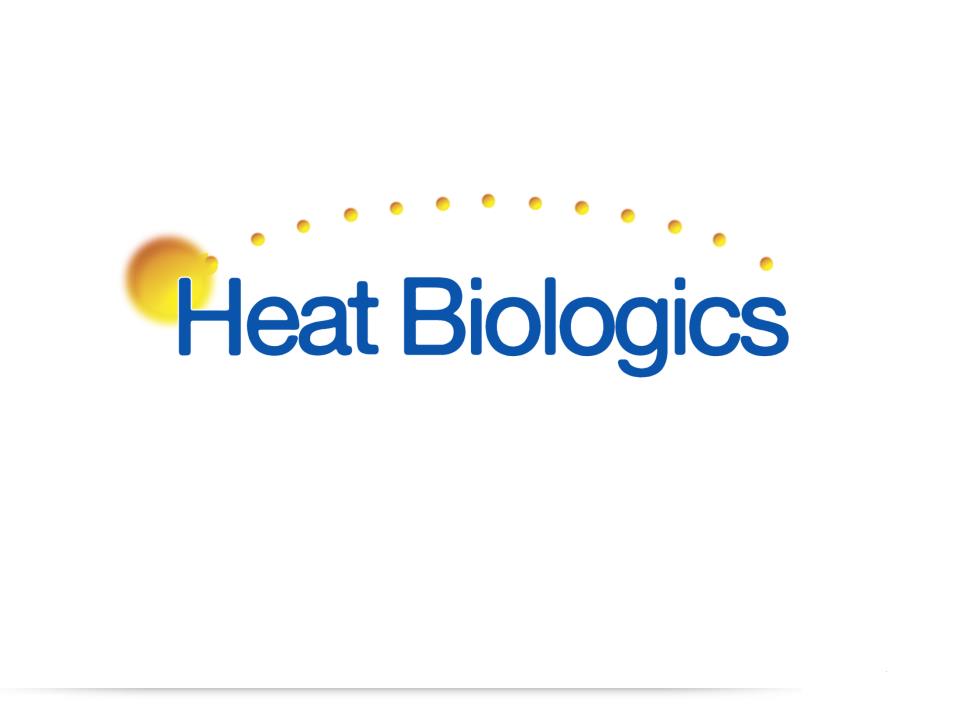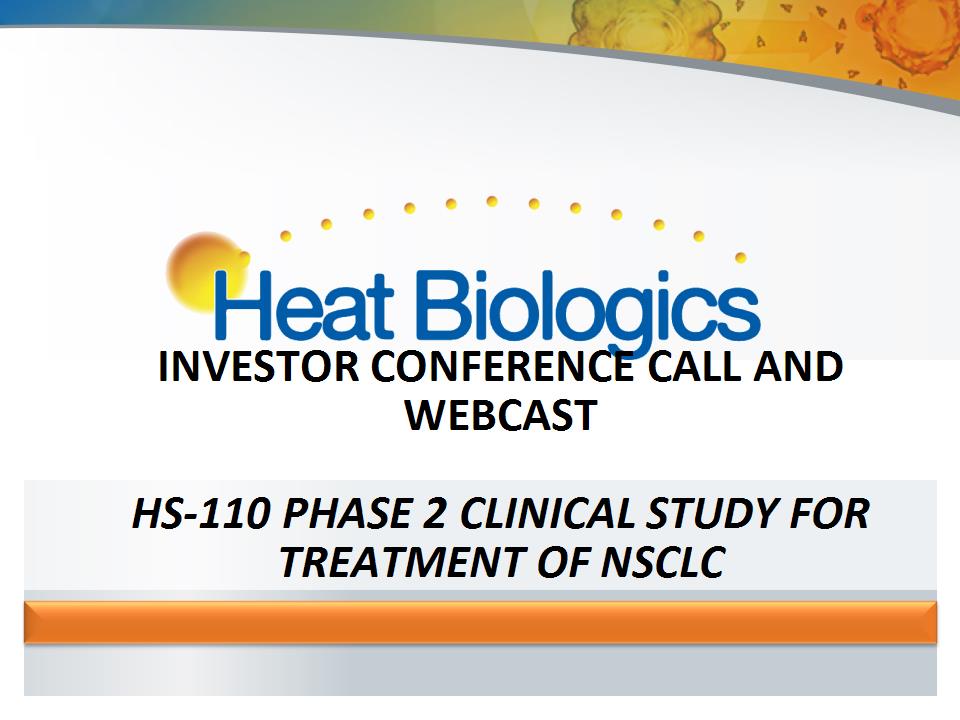
March 20, 2014

Forward Looking Statements
This presentation includes statements that are, or may be deemed, ‘‘forward-looking statements.’’ In some cases, these forward-looking
statements can be identified by the use of forward-looking terminology, including the terms “believes,” “estimates,” “anticipates,”
“expects,” “plans,” “intends,” “may,” “could,” “might,” “will,” “should,” “approximately” or, in each case, their negative or other variations
thereon or comparable terminology, although not all forward-looking statements contain these words. They appear in a number of
places throughout this presentation and include statements regarding our intentions, beliefs, projections, outlook, analyses or current
expectations concerning, among other things, our ongoing and planned discovery and development of drugs targeting cancer stem
cells, the strength and breadth of our intellectual property, our ongoing and planned preclinical studies and clinical trials, the timing of
and our ability to make regulatory filings and obtain and maintain regulatory approvals for our product candidates, the degree of clinical
utility of our products, particularly in specific patient populations, expectations regarding clinical trial data, our results of operations,
financial condition, liquidity, prospects, growth and strategies, the length of time that we will be able to continue to fund our operating
expenses and capital expenditures, our expected financing needs and sources of financing, the industry in which we operate and the
trends that may affect the industry or us.
statements can be identified by the use of forward-looking terminology, including the terms “believes,” “estimates,” “anticipates,”
“expects,” “plans,” “intends,” “may,” “could,” “might,” “will,” “should,” “approximately” or, in each case, their negative or other variations
thereon or comparable terminology, although not all forward-looking statements contain these words. They appear in a number of
places throughout this presentation and include statements regarding our intentions, beliefs, projections, outlook, analyses or current
expectations concerning, among other things, our ongoing and planned discovery and development of drugs targeting cancer stem
cells, the strength and breadth of our intellectual property, our ongoing and planned preclinical studies and clinical trials, the timing of
and our ability to make regulatory filings and obtain and maintain regulatory approvals for our product candidates, the degree of clinical
utility of our products, particularly in specific patient populations, expectations regarding clinical trial data, our results of operations,
financial condition, liquidity, prospects, growth and strategies, the length of time that we will be able to continue to fund our operating
expenses and capital expenditures, our expected financing needs and sources of financing, the industry in which we operate and the
trends that may affect the industry or us.
By their nature, forward-looking statements involve risks and uncertainties because they relate to events, competitive dynamics, and
healthcare, regulatory and scientific developments and depend on the economic circumstances that may or may not occur in the future
or may occur on longer or shorter timelines than anticipated. Although we believe that we have a reasonable basis for each forward-
looking statement contained in this presentation, we caution you that forward-looking statements are not guarantees of future
performance and that our actual results of operations, financial condition and liquidity, and the development of the industry in which we
operate may differ materially from the forward-looking statements contained in this presentation as a result of, among other factors, the
factors referenced in the “Risk Factors” section of our Registration Statement on Form S-1, as amended, declared effective by the
Securities and Exchange Commission on July 23, 2013 and our quarterly report on Form 10-Q for the period ended September 30,
2013 (collectively, our “SEC Filings”). In addition, even if our results of operations, financial condition and liquidity, and the development
of the industry in which we operate are consistent with the forward-looking statements contained in this presentation, they may not be
predictive of results or developments in future periods. Any forward-looking statements that we make in this presentation speak only as
of the date of such statement, and we undertake no obligation to update such statements to reflect events or circumstances after the
date of this presentation, except as required by law.
healthcare, regulatory and scientific developments and depend on the economic circumstances that may or may not occur in the future
or may occur on longer or shorter timelines than anticipated. Although we believe that we have a reasonable basis for each forward-
looking statement contained in this presentation, we caution you that forward-looking statements are not guarantees of future
performance and that our actual results of operations, financial condition and liquidity, and the development of the industry in which we
operate may differ materially from the forward-looking statements contained in this presentation as a result of, among other factors, the
factors referenced in the “Risk Factors” section of our Registration Statement on Form S-1, as amended, declared effective by the
Securities and Exchange Commission on July 23, 2013 and our quarterly report on Form 10-Q for the period ended September 30,
2013 (collectively, our “SEC Filings”). In addition, even if our results of operations, financial condition and liquidity, and the development
of the industry in which we operate are consistent with the forward-looking statements contained in this presentation, they may not be
predictive of results or developments in future periods. Any forward-looking statements that we make in this presentation speak only as
of the date of such statement, and we undertake no obligation to update such statements to reflect events or circumstances after the
date of this presentation, except as required by law.
You should read carefully our “Special Cautionary Notice Regarding Forward-Looking Statements” and the factors described in the
“Risk Factors” sections of our SEC Filings to better understand the risks and uncertainties inherent in our business.
“Risk Factors” sections of our SEC Filings to better understand the risks and uncertainties inherent in our business.
2

Agenda
l Introduction
– Jeff Wolf, Chief Executive Officer
l Overview of Heat’s ImPACT Technology
– Taylor H. Schreiber, M.D., Ph.D., Vice President of Research and Development
l Lung Cancer Market and Checkpoint Inhibitors
– Justin Stebbing, M.D., Ph.D., Chairman of Clinical Advisory Board and Chief Medical Advisor
l HS-110 Phase 2 Protocol Design
– Melissa Price, Ph.D., Vice President of Clinical and Regulatory Affairs
l Business Development Opportunity
– Anil K. Goyal, Ph.D., Vice President of Business Development
l Closing Comments
– Jeff Wolf, Chief Executive Officer
l Q&A
3
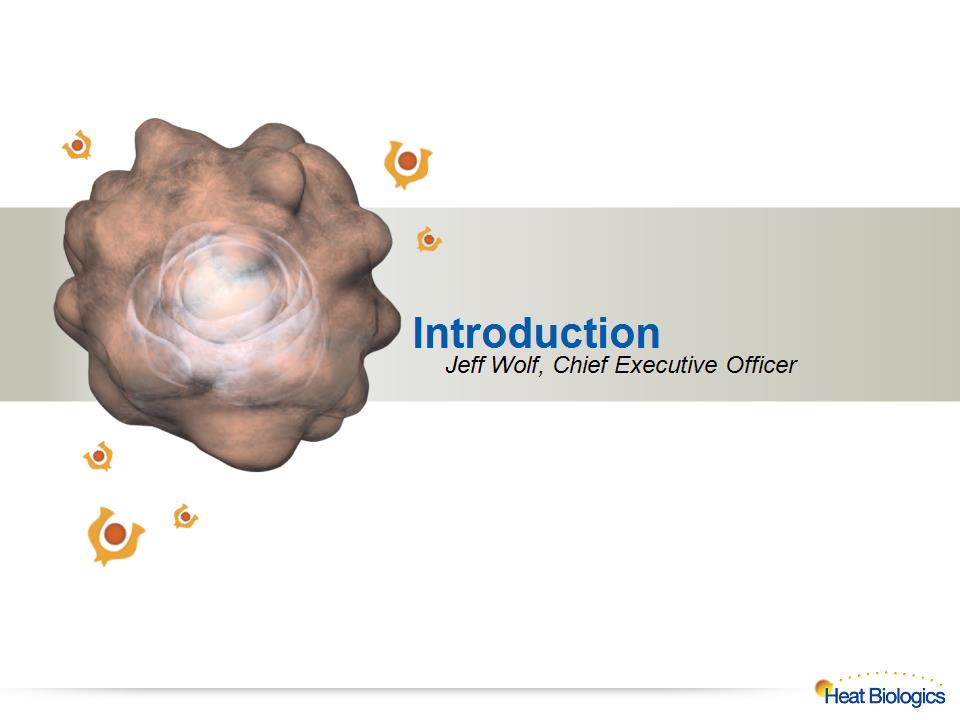
4

Company Highlights
5
ü Transformative, differentiated Immunotherapy platform generating
diverse pipeline with strong patent estate
diverse pipeline with strong patent estate
ü Promising clinical data yielding impressive survival supports 2
programs advancing into late-stage studies in 2014
programs advancing into late-stage studies in 2014
ü Clinical development programs with clear path to registration in high-
potential markets
potential markets
ü Robust business development initiative with potential for multiple
regional and global partnering opportunities
regional and global partnering opportunities
ü Experienced team with extensive oncology operational, scientific,
clinical and business development expertise
clinical and business development expertise
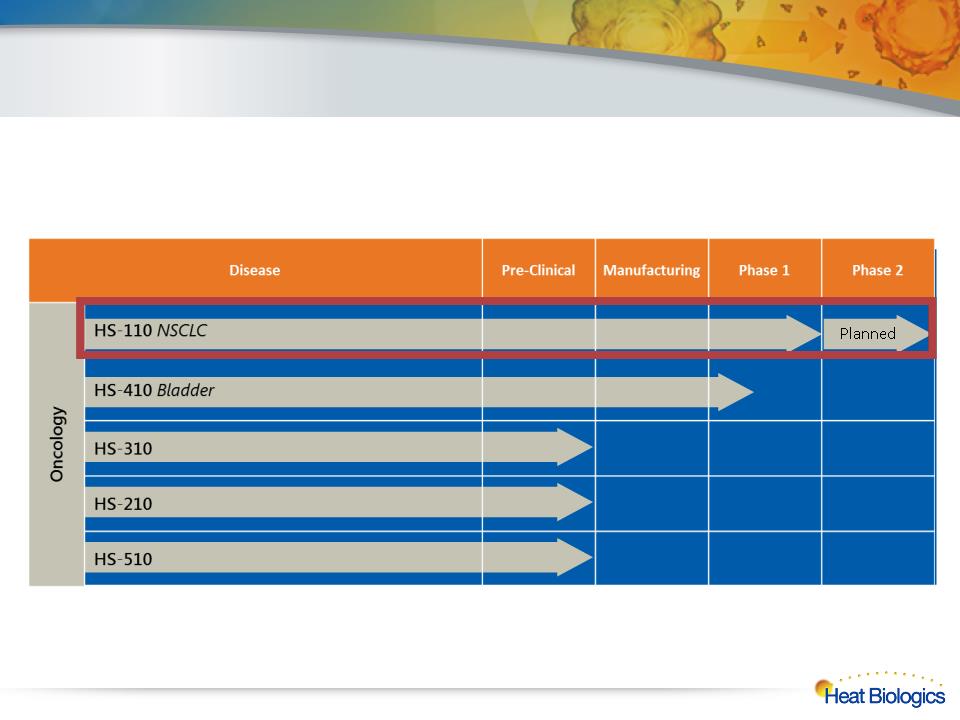
Diverse Pipeline with Multiple Registration Opportunities
6
From drug discovery to late-stage clinical development

Overview
7
Ø Management focused on advancing lead development programs HS-110
and HS-410 with proprietary ImPACT Technology
and HS-410 with proprietary ImPACT Technology
Ø Recent groundbreaking clinical development advancements studying
checkpoint inhibitors will be important for lung cancer treatment
checkpoint inhibitors will be important for lung cancer treatment
Ø Worked with preeminent KOL’s and advisors to optimize and revise HS-
110 NSCLC development program
110 NSCLC development program
Ø HS-110 Ph2 study specifically designed for future combination regimens
to address a large and growing market
to address a large and growing market
Ø Robust business development strategy in place to identify the best
development and commercialization partner
development and commercialization partner
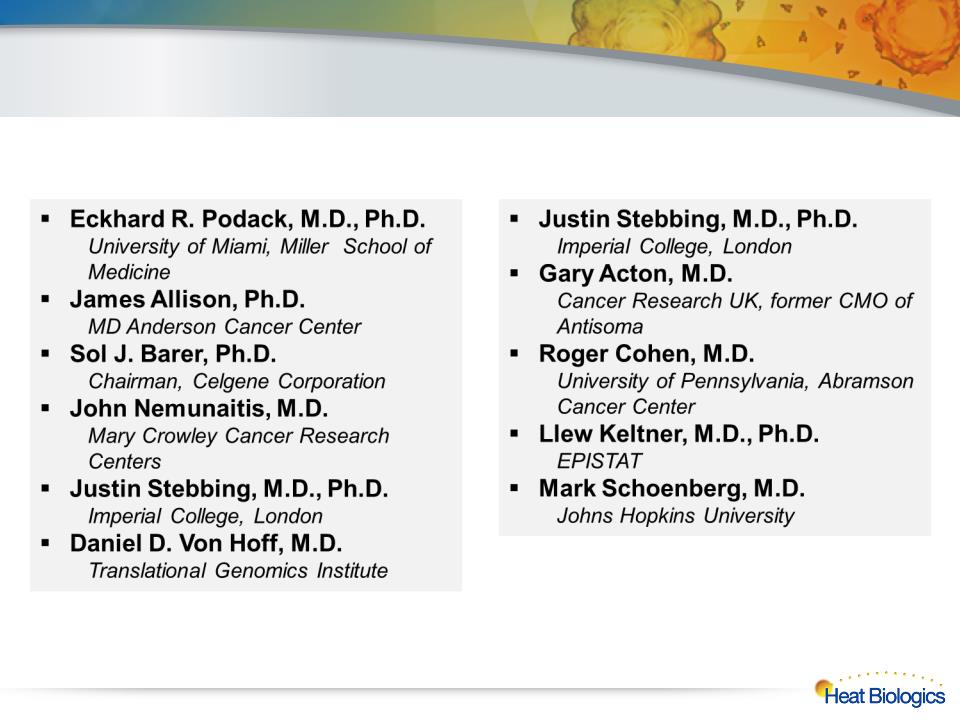
World Renowned Advisory Boards
8
Scientific Advisory Board
Clinical Advisory Board
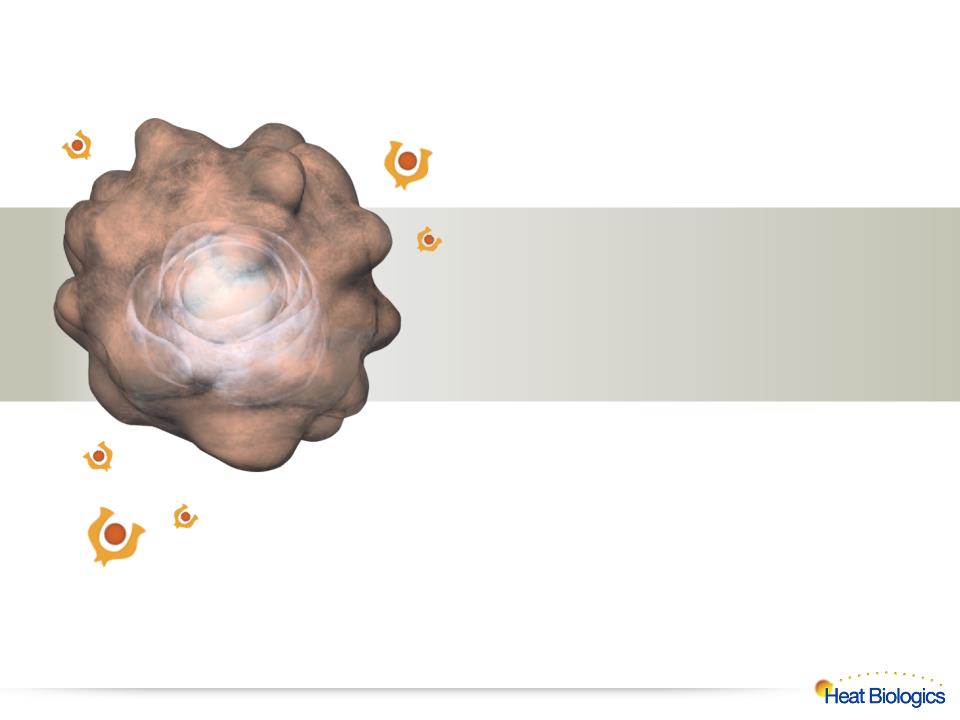
Heat’s ImPACT Therapy
Taylor H. Schreiber, M.D., Ph.D., Vice
President of Research and Development
Taylor H. Schreiber, M.D., Ph.D., Vice
President of Research and Development
9
Fully-Allogeneic Cell-based
Immunotherapy
Immunotherapy
Tumor associated antigens and powerful
adjuvant delivered in a single package
adjuvant delivered in a single package
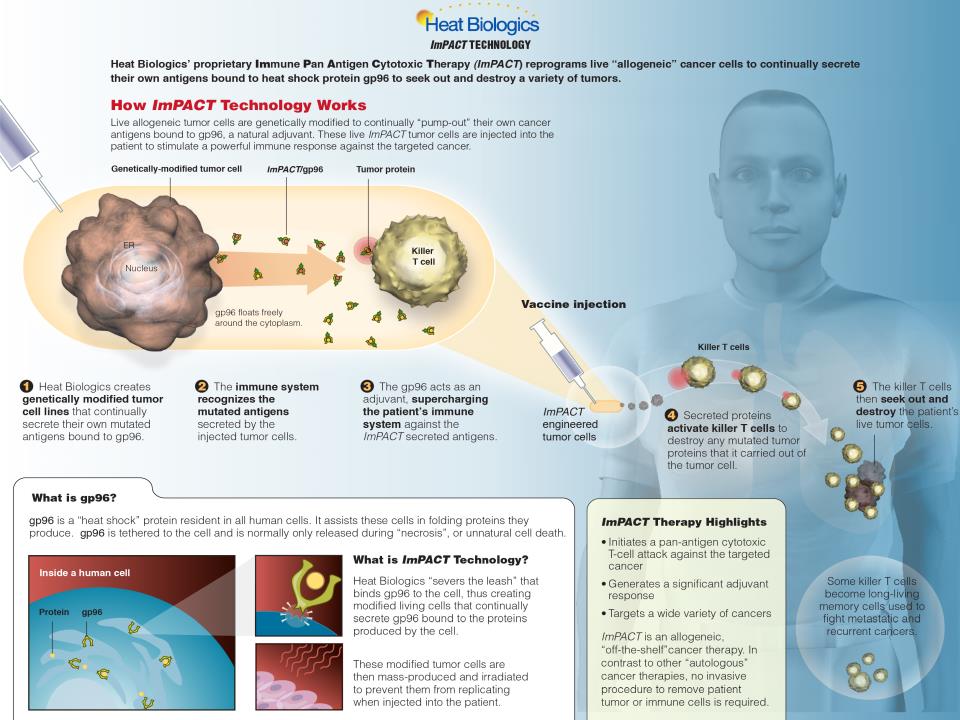

Introducing gp96 — Immune System’s “Swiss Army Knife”*
“Molecular Warning System”
* Schild, H. & Rammensee, H. Gp-96 - The Immune System’s Swiss Army Knife. Nature Immunology 2, 100
-101 (2000)
-101 (2000)
gp96
antigen
leash
l Natural biological process to deliver proteins (antigens)
+ gp96 adjuvant to our immune system
+ gp96 adjuvant to our immune system
l Gp96 “chaperones” newly-created proteins to the cell
membrane where they are released and embedded
membrane where they are released and embedded
l Activates a cytotoxic T-cell response to the antigen it is
carrying when cells die through necrosis
carrying when cells die through necrosis
– Enables MHC I antigen cross-presentation to CD8+ T-cells
l Gp96 + protein are only naturally released via necrosis
– Exposure of gp96 outside the cell activates an immune
response to the antigen it is carrying
response to the antigen it is carrying
– Enables MHC I antigen cross-presentation specifically to
CD8+ T-cells
CD8+ T-cells
l Among the most powerful adjuvants and the only
adjuvant to show exclusive specificity to CD8+ (“killer”)
T-cells
adjuvant to show exclusive specificity to CD8+ (“killer”)
T-cells
– Provides long-term immunity against the infectious agent
Tethered to our cells with a “KDEL” leash
Endoplasmic Reticulum
Cell Membrane
Antigen
11
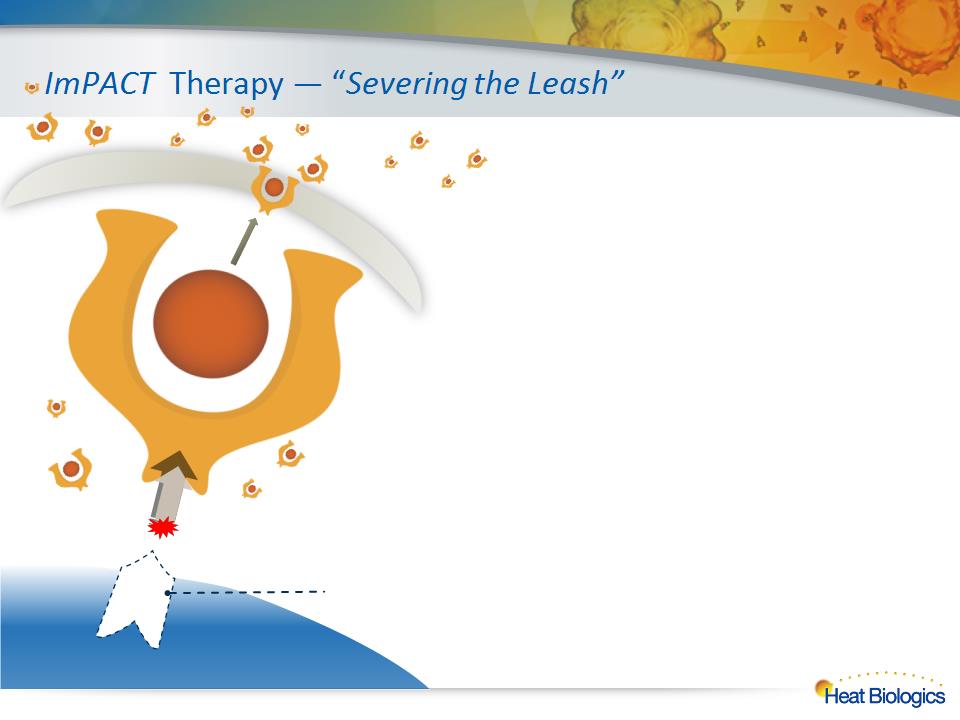
l Genetically modify tumor cells by “severing the
leash” that binds the gp96 to the endoplasmic
reticulum of the cell and replacing it with a
sequence that pumps gp96 out of the cell
leash” that binds the gp96 to the endoplasmic
reticulum of the cell and replacing it with a
sequence that pumps gp96 out of the cell
l Enables living cancer cells to “pump-out” their own
surface antigens along with their gp96 chaperone
surface antigens along with their gp96 chaperone
– Mimics necrotic cell death
l Activates a powerful pan-antigen cytotoxic T-cell
immune response
immune response
Heat Biologics ImPACT technology removes the leash that binds
gp96 to the cell, replacing with a sequence that allows cells to
continually secrete gp96 along with their “chaperoned” antigen
gp96 to the cell, replacing with a sequence that allows cells to
continually secrete gp96 along with their “chaperoned” antigen
Cell Membrane
12
Heat Biologics ImPACT technology reprograms
cancer cells to continuously secrete their own
antigens bound to heat shock protein gp96 to
seek out and destroy a variety of tumours
cancer cells to continuously secrete their own
antigens bound to heat shock protein gp96 to
seek out and destroy a variety of tumours
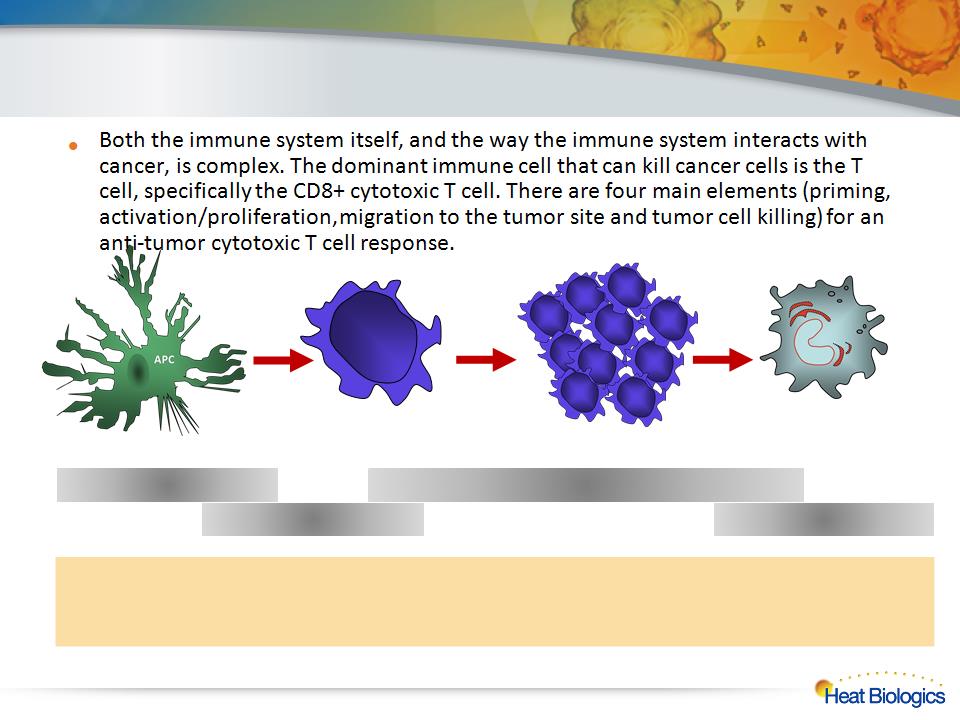
13
CD8+
Priming Activation Proliferation Migration/Killing
Vaccines
Checkpoint Inhibitors
Checkpoint Inhibitors
T Cell Co-stimulators / TNFRSF Targets
Immuno-Oncology Vision
Preclinical data indicate that ImPACT vaccines synergize with checkpoint inhibitors and
T cell costimulators. It is anticipated that combination clinical trials with these agents
will provide similar benefit by addressing each phase of anti-tumor immunity.
T cell costimulators. It is anticipated that combination clinical trials with these agents
will provide similar benefit by addressing each phase of anti-tumor immunity.
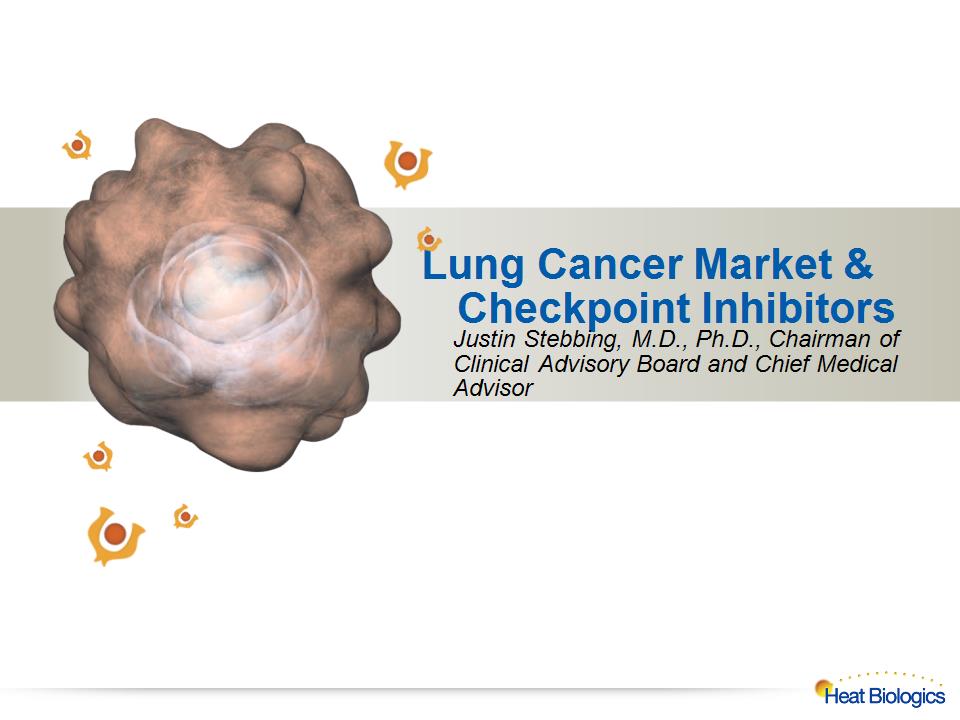
14
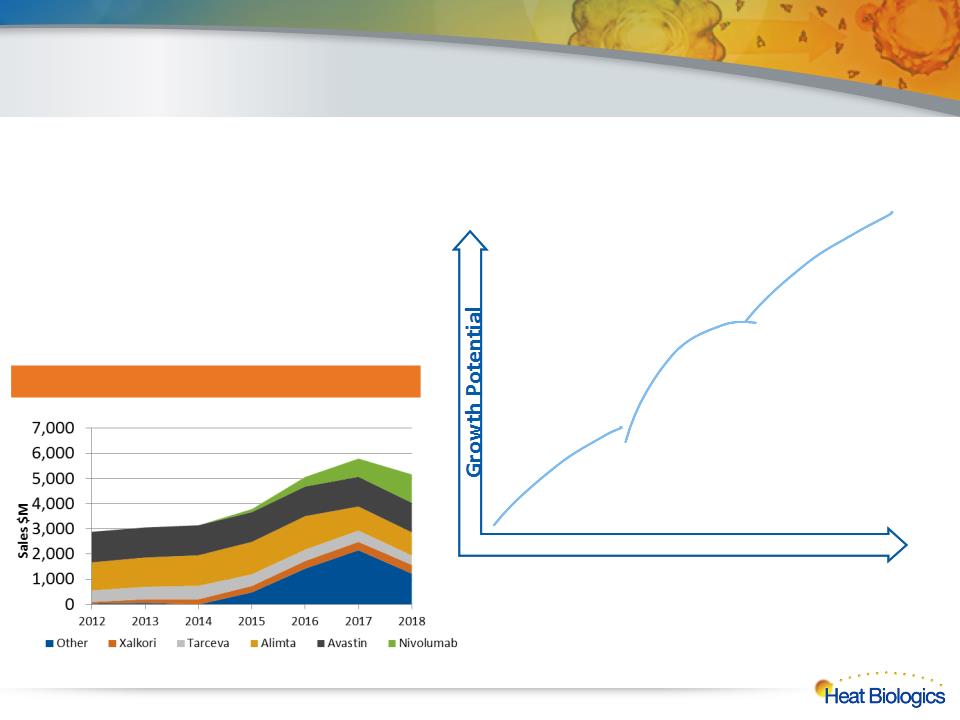
l In 2020 Estimated adeno NSCLC Patients
– ~291,000 new cases per year
(US alone)
(US alone)
l Target US Patient Population in 2020
– ~22,000 will receive 3L therapy
HS-110
NSCLC Third Line (3L) adenocarcinoma
opportunity
NSCLC Third Line (3L) adenocarcinoma
opportunity
15
Forecast NSCLC Total US Market (US$)
Source: Catenion Research
3L adv.
NSCLC
2L, 1L,
Maintenance,
Brain mets,
resectable
Maintenance,
Brain mets,
resectable
Combo with
Checkpoint
inhibitors &
co-stimulators
Checkpoint
inhibitors &
co-stimulators

Rationale for Study
l Address unmet need by offering patients access to investigational agents with
presumably a more favorable safety profile than chemo in a setting where
there is little approved in 3rd-line and the efficacy of these agents is minimal
presumably a more favorable safety profile than chemo in a setting where
there is little approved in 3rd-line and the efficacy of these agents is minimal
l Maximize antigen expression overlap by testing an adenocarcinoma vaccine
to an adenocarcinoma population
to an adenocarcinoma population
l Mimic future combinations with checkpoint inhibitors by utilizing low-dose
cyclophosphamide
cyclophosphamide
l Evaluate the effect of concomitant chemotherapy on the immune response to
HS-110 and of subsequent chemotherapy after HS-110 tumor response
HS-110 and of subsequent chemotherapy after HS-110 tumor response
l Evaluate multiple endpoints due to short time to event in this population
(overall survival, objective response, disease control rate, PFS, immune
response, 6-mo OS, 12-mo OS)
(overall survival, objective response, disease control rate, PFS, immune
response, 6-mo OS, 12-mo OS)
l Capture pre- and post-treatment biopsy tissue when appropriate in order to
correlate antigen expression, TILs and T-cell receptor sequences with
outcomes, potentially leading to proof of concept and precision in patient
selection
correlate antigen expression, TILs and T-cell receptor sequences with
outcomes, potentially leading to proof of concept and precision in patient
selection
16
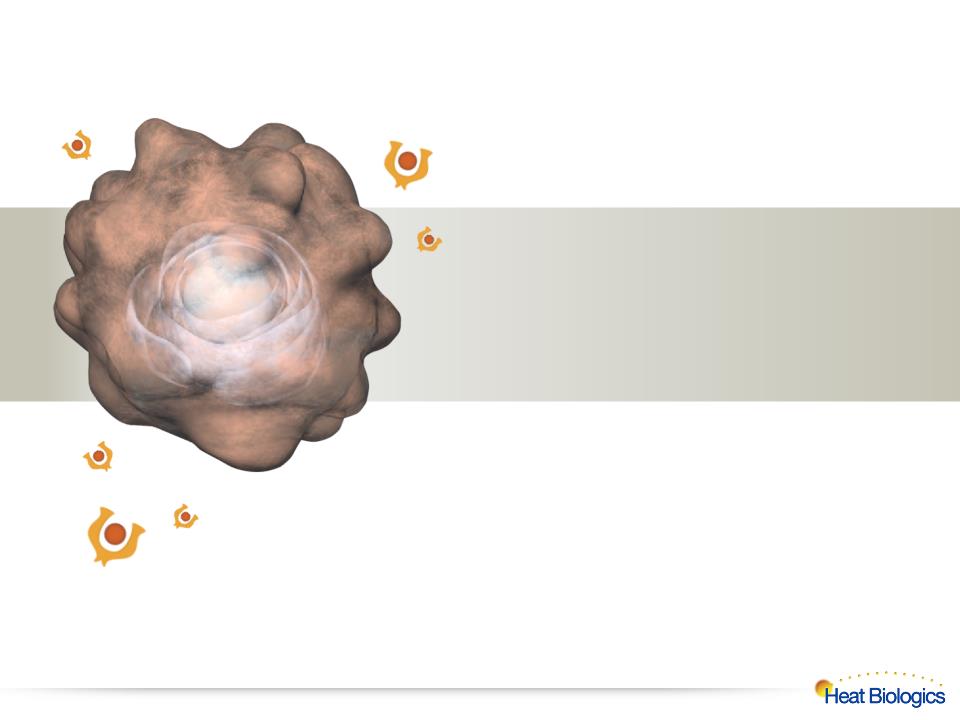
HS-110 Phase 2 Protocol
Design
Melissa Price, Ph.D., Vice President of Clinical
and Regulatory Affairs
Design
Melissa Price, Ph.D., Vice President of Clinical
and Regulatory Affairs
17
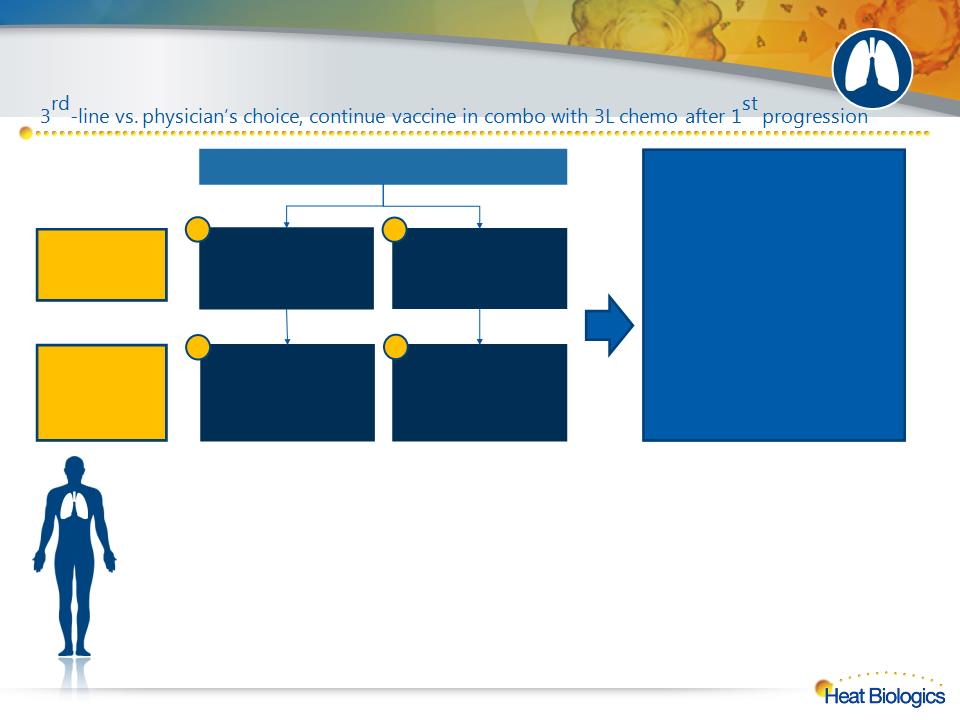
©2013 Heat Biologics
Regimen
l Low-dose cyclophosphamide (CY) 50 mg daily for 7 days q2weeks for 12 weeks or until 1st
progression
progression
l HS-110 107 cells weekly for 12 weeks then q3 weeks until 2nd irPD or 24 months
whichever comes first
whichever comes first
Sample Size
l 123 patients randomized 2:1
l 80% power with alpha = 0.1 to detect a 50% reduction in the risk of death with 59 events
in the experimental group and 33 events in the control group
in the experimental group and 33 events in the control group
Phase 2 HS-110/CY Combo NSCLC Design
Randomized
HS-110 + low-dose
CY
CY
Vinorelbine OR
erlotinib OR
gemcitabine OR
paclitaxel
erlotinib OR
gemcitabine OR
paclitaxel
Endpoints
Primary: overall survival
Secondary: immune response
in blood,
in blood,
PFS, DCR, ORR by irRC and
RECIST
RECIST
6-mo OS, 12-mo OS
Pre- and post-treatment biopsy
tissue for exploratory
biomarker analyses
tissue for exploratory
biomarker analyses
Arm 1; N=82
Arm 2; N=41
3rd-line - Stage
A
A
4th-line - Stage
B
B
HS-110 + Vinorelbine
OR erlotinib OR
gemcitabine OR
paclitaxel
OR erlotinib OR
gemcitabine OR
paclitaxel
Vinorelbine OR
erlotinib OR
gemcitabine OR
paclitaxel
erlotinib OR
gemcitabine OR
paclitaxel
First Progression
1
2
3
4
18
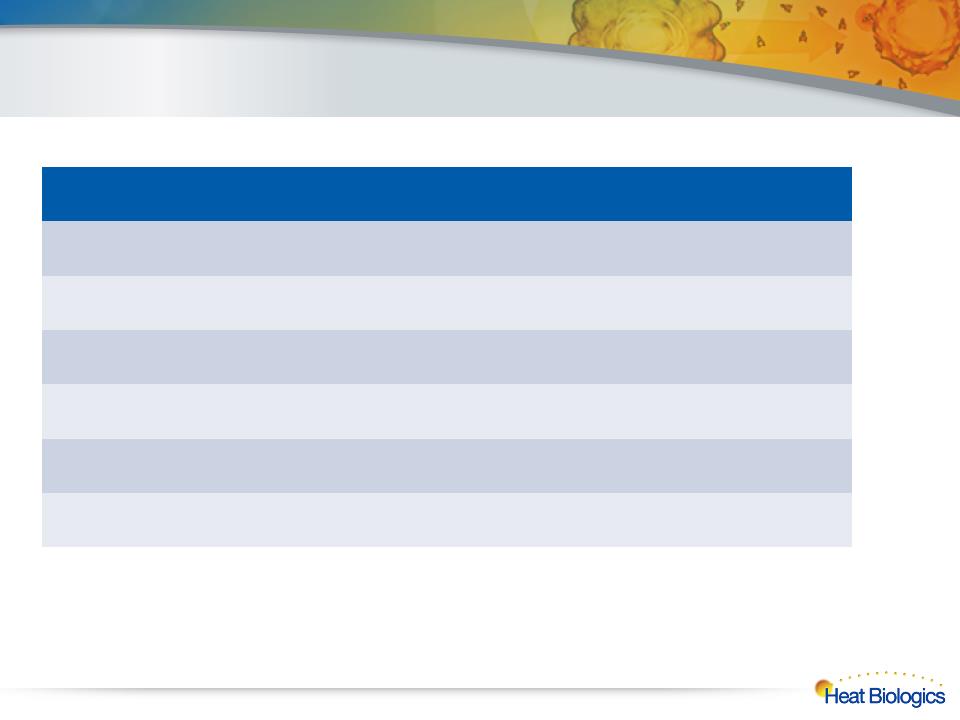
Key Study Timelines and Milestones
Milestone | Target Completion |
FDA Submission | ü 1Q 2014 |
First patient enrolled | Q3 2014 |
Enrollment complete | Q2 2016 |
Antigen expression readout | Q4 2016 |
Top-line efficacy readout | Q3 2017 |
Phase 3 trial commences | Q4 2017 |
19
Phase 2 Clinical Trial for NSCLC
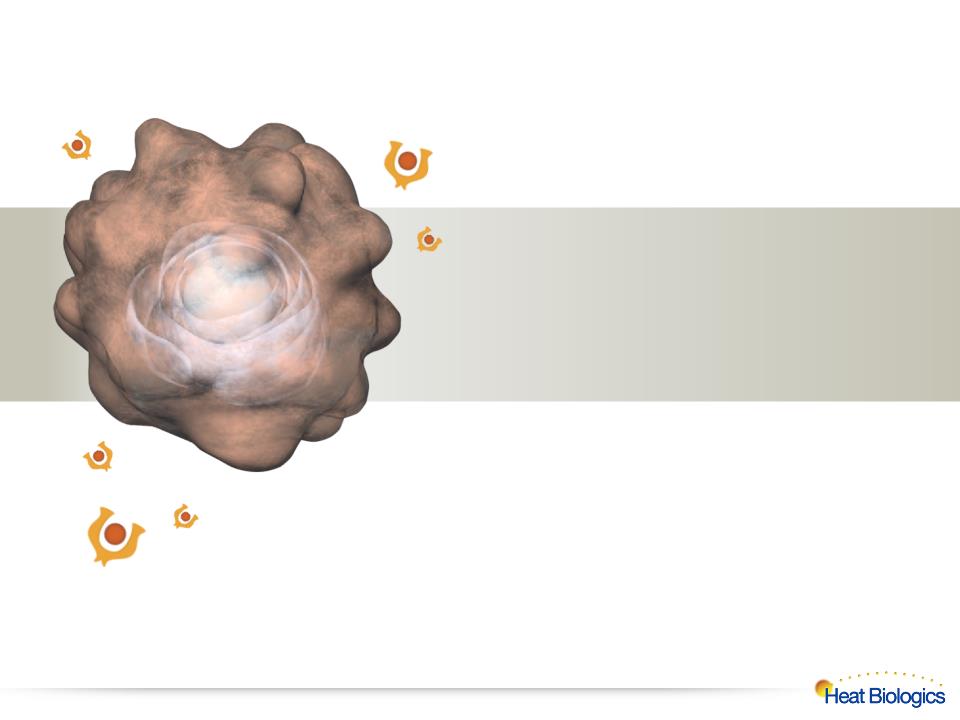
Business Development
Opportunity
Anil K. Goyal, Ph.D., Vice President of
Business Development
Opportunity
Anil K. Goyal, Ph.D., Vice President of
Business Development
20

Business Development Strategy
Heat’s ImPACT Immunotherapy platform is:
–Differentiated from other allogeneic cell-based approaches
–Extended half life of antigen release, potentially more effective in generating immune
response
response
–Complementary with checkpoint inhibitors and could expand application of CPI into
non-immunogenic cancers
non-immunogenic cancers
1.Clinical Programs (HS-110, HS-410)
• Ideal partner with regional capabilities to fund and expand in EU, Asia, AU
• Heat to retain US commercialization rights (where possible)
2.ImPACT Platform Partnerships
• Use platform for new product discovery funded by partner
• Partner by specific indication(s)
• Clinical development & commercialization by partner in selected territories,
• Heat retaining rest of the world rights
3.MoA complementary with checkpoint inhibitors
• Explore co-development partnerships with anti-PD1 & anti-PDL1 products
21
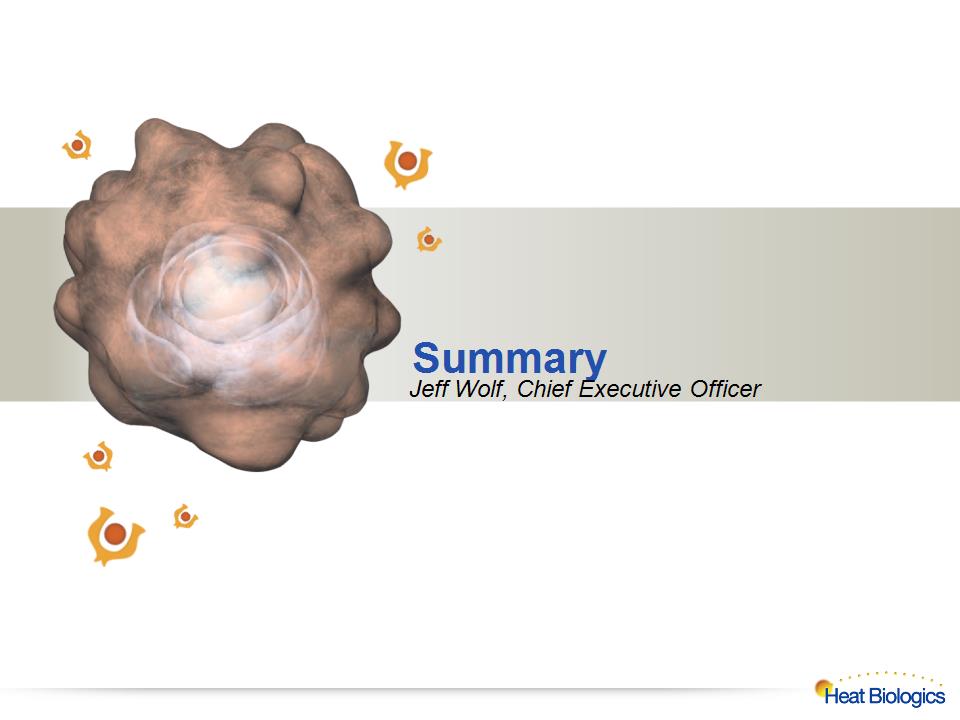
22

HS-110 Lung Cancer Program Designed for Success
23
üTransformative, differentiated Immunotherapy
platform with clinical data supporting
advancement into Phase 2 program
platform with clinical data supporting
advancement into Phase 2 program
üRevised protocol developed in collaboration
with world’s leading KOLs and lung experts
with world’s leading KOLs and lung experts
üProgram specifically designed with potential to
be complementary in combination with next
generation oncology treatments
be complementary in combination with next
generation oncology treatments
üHS-110 with potential to be highly attractive to
potential development and commercialization
partners
potential development and commercialization
partners
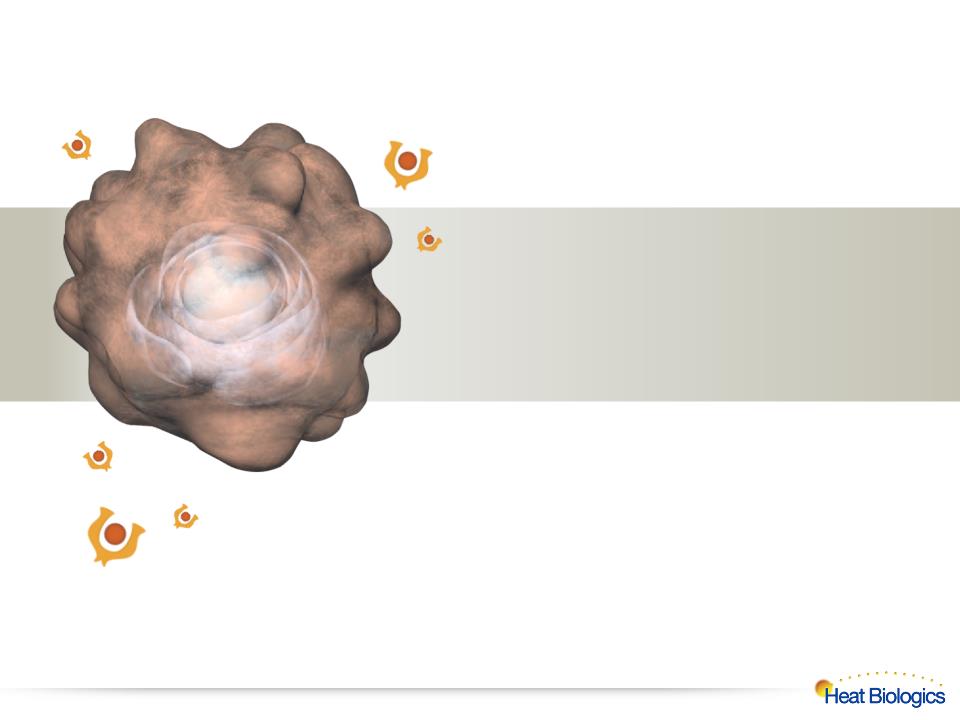
Q&A
24
